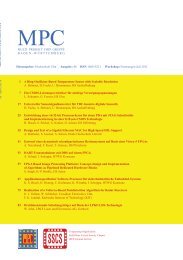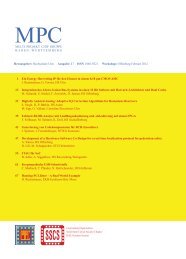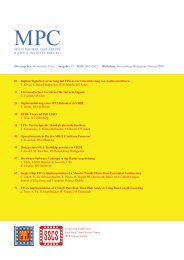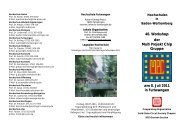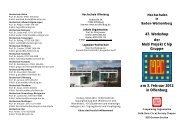Workshopband als PDF - Mpc.belwue.de
Workshopband als PDF - Mpc.belwue.de
Workshopband als PDF - Mpc.belwue.de
Erfolgreiche ePaper selbst erstellen
Machen Sie aus Ihren PDF Publikationen ein blätterbares Flipbook mit unserer einzigartigen Google optimierten e-Paper Software.
MPC-WORKSHOP FEBRUAR 2013<br />
Figure 4: IV-characteristic of green light emitting LED, measured<br />
data (red dot) together with simulated curve (full line) after parameter<br />
optimization and photodio<strong>de</strong> data showing the light<br />
emission.<br />
Figure 5: IV-characteristic of red light emitting LED, measured<br />
data (red dot) together with simulated curve (full line) after parameter<br />
optimization and photodio<strong>de</strong> data showing the light<br />
emission.<br />
The application of the general mo<strong>de</strong>l (figure 2) on<br />
the green light emitting dio<strong>de</strong> gives the curve shown<br />
in figure 4. Measured data can only be reproduced by<br />
simulation based on the complete mo<strong>de</strong>l. Due to the<br />
fact that the emission coefficient of the parallel dio<strong>de</strong><br />
DP2 amounts to close to N = 500, which corresponds<br />
to a slope of the curve in this section close to zero,<br />
dio<strong>de</strong> DP2 can be replaced by a resistor RP with very<br />
similar simulation results. This alternative mo<strong>de</strong>l has<br />
the advantage of less mo<strong>de</strong>l parameters and can always<br />
be applied when the slope of the IV characteristic<br />
in the low voltage region is close to zero.<br />
To mo<strong>de</strong>l the red light emitting dio<strong>de</strong> (figure 5) the<br />
general mo<strong>de</strong>l can be simplified as following. Only<br />
the main dio<strong>de</strong> DM together with the serial resistance<br />
is necessary to mo<strong>de</strong>l the active region of the LED.<br />
The horizontal sub threshold part of the IV characteristic<br />
can be mo<strong>de</strong>led with a parallel resistance RP. An<br />
additional serial dio<strong>de</strong> DS will give only small improvement<br />
in the reproduction of the measured data by<br />
the mo<strong>de</strong>l. In summary the mo<strong>de</strong>l consists only in the<br />
elements RS, DM and RP.<br />
Figure 6: IV-characteristic of blue light emitting LED, measured<br />
data (red dot) together with simulated curve (full line) after parameter<br />
optimization and photodio<strong>de</strong> data showing the light<br />
emission.<br />
Figure 7: Temperature <strong>de</strong>pen<strong>de</strong>nce of the IV-characteristic of blue<br />
light emitting LED, measured data (dotted) together with simulated<br />
curves (full line) at 30°C (blue), 50°C (red) and 70°C (green).<br />
Finally, data of the blue light emitting dio<strong>de</strong> are given<br />
in figure 6. As for the green light emitting dio<strong>de</strong><br />
two parallel electrical components in addition to the<br />
main dio<strong>de</strong> DM are necessary. The not vanishing<br />
slope of the IV characteristic in the low-voltage region<br />
indicates that the parallel dio<strong>de</strong> DP2 cannot be replaced<br />
here by a parallel resistor. From the sensitivity<br />
analysis we can conclu<strong>de</strong> that the serial dio<strong>de</strong> DS is<br />
not necessary to mo<strong>de</strong>l the IV characteristic of this<br />
LED.<br />
B. Temperature <strong>de</strong>pen<strong>de</strong>nce<br />
LED’s especially used in outdoor technology will<br />
work un<strong>de</strong>r very different ambient temperature conditions.<br />
Consequently it is necessary to verify the validity<br />
of the mo<strong>de</strong>l for different temperatures. Main Spice<br />
parameters <strong>de</strong>scribing the temperature <strong>de</strong>pen<strong>de</strong>nce of<br />
the saturation current IS(T) are the energy gap EG and<br />
the saturation current temperature exponent XTI [2].<br />
Consequently, for an accurate <strong>de</strong>scription of the temperature<br />
<strong>de</strong>pen<strong>de</strong>nce the knowledge of EG, which is<br />
given by the material composition of the LED [1] is<br />
necessary. This knowledge is not available for us.<br />
However, the energy gap is related to the wavelength<br />
15


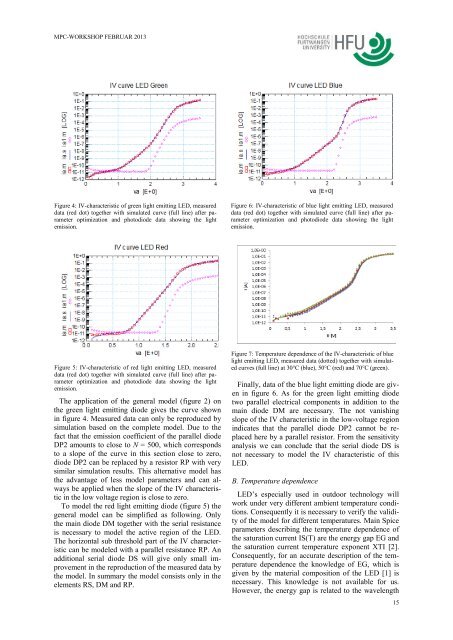
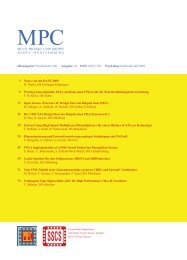
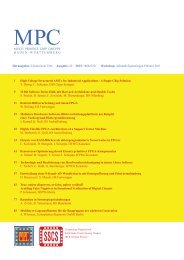
![[Geben Sie hier die Überschrift ein] - MPC](https://img.yumpu.com/8654082/1/188x260/geben-sie-hier-die-uberschrift-ein-mpc.jpg?quality=85)
